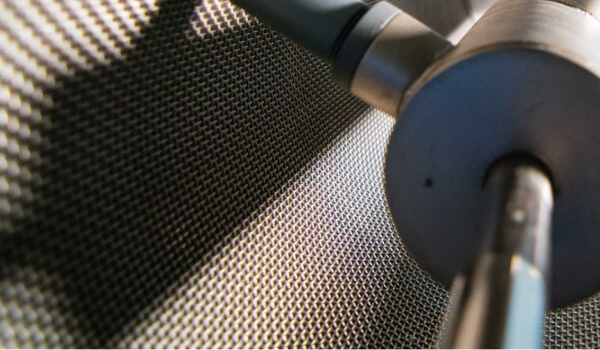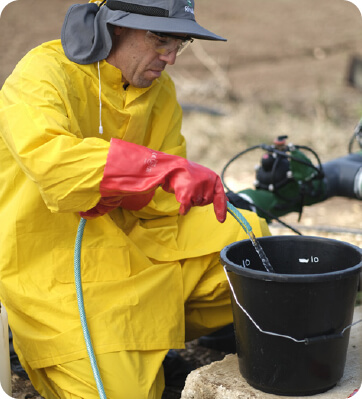Maintenance – disc filters
To maintain the discs in good condition, seasonal maintenance is required. It is recommended to perform a manual disc clean once a year, which in addition to cleaning with a pressure washer, it should include a chemical treatment depending on your requirements:
1. Depressurize the system.

2. Close the inlet and outlet valves of the system. Open the drain valve in the lower filter manifold to drain the filter.
3. Open the disc filter housing and release the piston holding the discs pressed together.
4. Remove the discs (thread with a wire to keep them together/in order) and pressure wash until the disc grooves are cleaned.
5. A soft nylon brush can be used if required.
6. Visually inspect and replace any damaged disc.
7. After cleaning is over, tighten the discs to the proper position, or proceed to chemical treatment.
Depending on your water source, you will need to clean the discs to remove organic/biological or manganese/iron/carbonate residue. The process for each cleaning technique is described below.
Manual disc cleaning for surface water with organic and biological residue
1. Remember to have a wire threaded through the discs to keep them together/in order.
2. Create the first cleaning solution – mix 10 liters (quarts) of water with 5 liters (quarts) of hydrogen peroxide.
The 5 liters of the hydrogen peroxide should be at 10% concentration to give a total of 3.33% of H2O2 in the bucket.
Peroxide is dangerous and its use should be in compliance with LOCAL safety LAWS/REGULATIONS. To learn about the health and environmental hazards and the required safety means read the safety data sheets of such materials. Please also refer to the oxidizing treatment guidelines.
3. Soak the discs in the solution for one hour (lightly stirring occasionally).
4. Rinse the discs with water. If at this stage the discs are clean, you can skip to step 8.
5. Create the second cleaning solution – mix 10 liters (quarts) of water with 5 liters (quarts) of hydrochloric acid, being careful to add the acid to the water. Do not pour water into concentrated acid, as it will violently react which is very dangerous. The 5 liters of the hydrochloric acid should be at 10% concentration to give a total of 3.33% of HCl in the bucket.
6. Soak the discs in the solution for one hour (lightly stirring occasionally).
Acid is dangerous and its use should be in compliance with LOCAL safety LAWS/REGULATIONS. To learn about the health and environmental hazards and the required safety means read the safety data sheets of such materials. Please also refer to the acid handling guidelines.
7. Rinse the discs with water.
8. Reassemble the disc cartridge and replace the covers to reassemble the filter array.
9. Close the drain valve on the outlet manifold.
10. Gradually open the upstream manual valve and then the downstream valve.
11. Pressurize the system.
12. Manually flush to test the system and tor remove any chemicals before resuming normal operation.
Transparent filter cover only to show water movement during flushing.
Manual disc cleaning for well water with manganese, iron or carbonates
1. Remember to have a wire threaded through the discs to keep them together/in order.
2. Create the first cleaning solution – mix 10 liters (quarts) of water with 5 liters (quarts) of hydrochloric acid, being careful to add the acid to the water.
Do not pour water into concentrated acid, as it will violently react which is very dangerous. The 5 liters of the hydrochloric acid should be at 10% concentration to give a total of 3.33% of HCl in the bucket.
3. Soak the discs in the solution for one hour (lightly stirring occasionally).
Acid is dangerous and its use should be in compliance with LOCAL safety LAWS/REGULATIONS. To learn about the health and environmental hazards and the required safety means read the safety data sheets of such materials. Please also refer to the acid handling guidelines.
4. Rinse the discs with water. If at this stage the discs are clean, you can skip to step 8.
5. Create the second cleaning solution – mix 10 liters (quarts) of water with 5 liters (quarts) of hydrogen peroxide.
The 5 liters of the hydrogen peroxide should be at 10% concentration to give a total of 3.33% of H2O2 in the bucket.
6. Soak the discs in the solution for one hour (lightly stirring occasionally).
7. Rinse the discs with water.
8. Reassemble the disc cartridge and replace the covers to reassemble the filter array.
9. Close the drain valve on the outlet manifold.
10. Gradually open the upstream manual valve and then the downstream valve.
11. Pressurize the system.
12. Manually flush to test the system and to remove any chemicals before resuming normal operation.
Peroxide is dangerous and its use should be in compliance with LOCAL safety LAWS/REGULATIONS. To learn about the health and environmental hazards and the required safety means read the safety data sheets of such materials. Please also refer to the oxidizing treatment guidelines.
During the season
- Periodically inspect the discs and clean as per the previous section.
Start/end of each season
- The manual cleaning process should be completed at least once a year.
- Reapply silicone grease to all O-rings.
- Test the back-flush (if an automatic filter).
Additional maintenance for automatic disc filters
During the season
For automatic disc filters – test the back-flush.
• The back-flush should occur at maximum 0.5 bar (7 psi) pressure differential.
• The back-flush time should be 30 seconds for each filter pod. Although this can be adjusted, it should not be less than 20 seconds.
• Check that water is being expelled from each drainage pipe during the back-flush process.
• If you find that your filter is continually flushing, this is a sign of a blocked filter and the filter discs need to be manually cleaned.
• The back-flush valve needs minimum 1 bar (14.5psi) to open. And in order to perform an efficient cleaning we recommend to have 2.5 bar (36.25 psi) at the downstream.
Watch some of the above maintenance tasks in our F7250 maintenance video.
https://www.youtube.com/watch?v=ACGk5lgEMN8












































